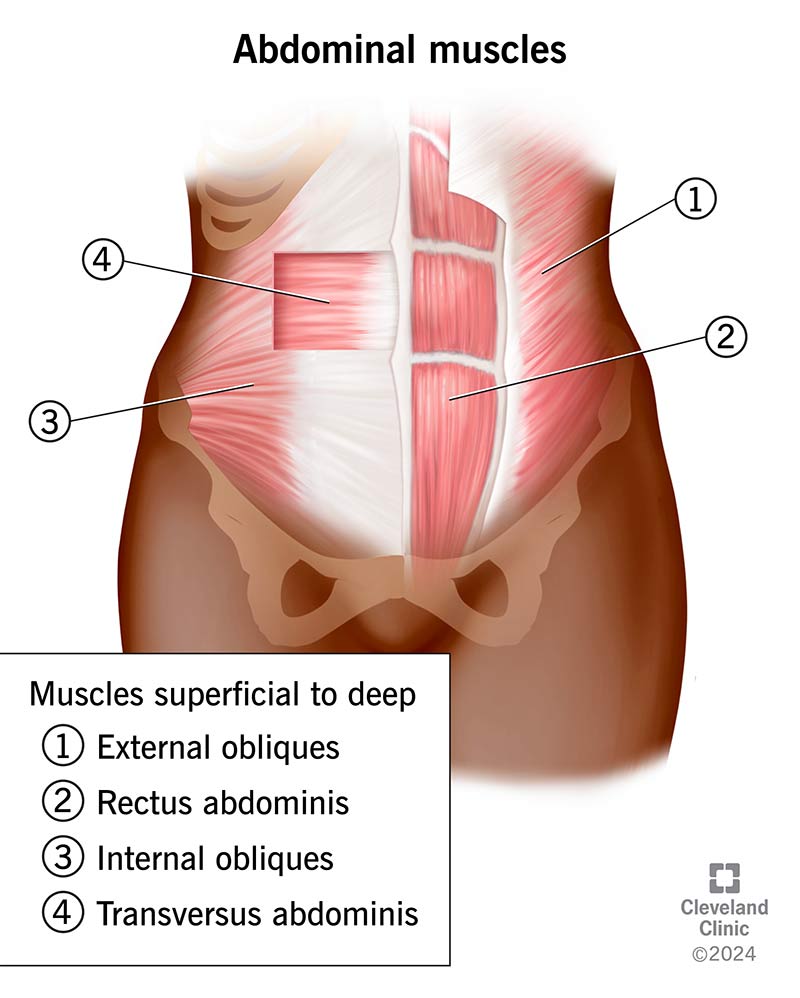Your abdominal muscles have many important functions, from holding organs in place to supporting your body during movement. There are five main muscles: pyramidalis, rectus abdominus, external obliques, internal obliques and transversus abdominis. Ab strains and hernias are common, but several strategies can keep your abs safe and healthy.
Advertisement
Cleveland Clinic is a non-profit academic medical center. Advertising on our site helps support our mission. We do not endorse non-Cleveland Clinic products or services. Policy

Your abdominal muscles are strong bands of muscles lining the walls of your abdomen (trunk of your body). They’re located toward the front of your body, between your ribs and your pelvis. Your abdominal muscles have many important roles, including supporting your trunk, helping with movement and holding your organs in place.
Advertisement
Cleveland Clinic is a non-profit academic medical center. Advertising on our site helps support our mission. We do not endorse non-Cleveland Clinic products or services. Policy
The five main muscles in your abdomen are:
Together with your back muscles, your abdominal muscles make up your “core” muscles. They help protect your spine and keep your body stable and balanced.
Your abdominal muscles have several important jobs:
Your abdominal muscles are located between your ribcage and your pelvis on the front of your body.
Your abdominal muscle anatomy consists of five pairs of muscles. Two are vertical (up and down) muscles located toward the middle of your body. Three are flat muscles stacked on top of each other, situated toward the sides of your trunk.
Advertisement
The two vertical muscles are:
The three flat muscles are:
Several conditions can affect your abdominal wall muscles.
The most common condition affecting the abdominal muscles is abdominal strains. Also called a pulled abdominal muscle, these occur with:
Strains can involve anything from tiny, minor tears in your muscle fibers to severe pulls that can even detach your muscle. This type of injury is more common in sports that require twisting, like tennis, football, baseball and golf.
Another health issue in the abdominal muscles is a hernia. A hernia is when an internal organ pushes through a weak spot in your muscle. For example, your small intestines may push through a weakened abdominal muscle in your groin area, causing an inguinal hernia.
Another condition that can affect the abdominal muscles is prune belly syndrome. This is a rare condition in which your newborn has absent or weak abdominal wall muscles at birth, making their belly (abdomen) look wrinkled. Other features of the disease include undescended testicles and urinary system problems.
Symptoms of abdominal muscle conditions depend on the type of injury or disease.
Symptoms of a significant strain include:
Advertisement
Symptoms of a hernia include:
Treatments for abdominal muscle conditions depend on the type of injury or disease.
Treatment for an abdominal strain may involve:
Treatment for a hernia typically includes surgical repair:
Advertisement
Treatment for prune belly syndrome may include:
Several strategies can help you prevent ab injuries:
If you have symptoms of a significant abdominal strain, call your healthcare provider, especially if you have trouble:
Advertisement
In addition, if you can see or feel a bulge in your abdomen or in your groin, you should be evaluated for a hernia.
Your abdominal muscles are essential in keeping your abdominal organs safe and stabilizing your body during movement. Problems with the abdominal muscles are common. If you think you’ve strained an abdominal muscle, call your healthcare provider, especially if pain interferes with your everyday activities. If you can see or feel a bulge in your abdomen/groin, see your provider.
Cleveland Clinic’s primary care providers offer lifelong medical care. From sinus infections and high blood pressure to preventive screening, we’re here for you.

Last reviewed on 06/05/2024.
Learn more about the Health Library and our editorial process.